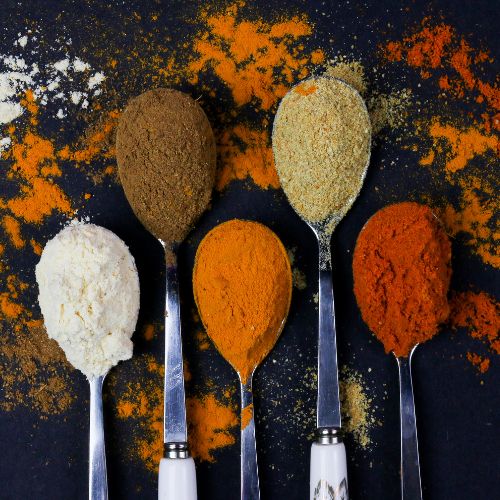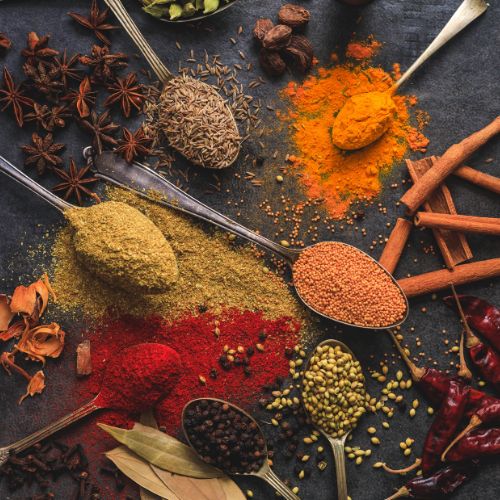Spices That Start With K
Spices play a crucial role in culinary skills and the overall gastronomic experience. These aromatic substances, derived from various parts of plants such as seeds, bark, roots, and fruits, add depth, flavor, and complexity to dishes, elevating them from ordinary to extraordinary.
One of the primary purposes of spices in cooking is to enhance the taste and aroma of food. Each spice possesses unique flavors and characteristics that contribute to the overall sensory experience. Whether it’s the warmth of cinnamon, the heat of chili peppers, or the earthiness of cumin, spices bring diversity and excitement to a dish.
Spices are not only responsible for enhancing flavor but also for providing health benefits. Many spices possess antioxidant, anti-inflammatory, and antimicrobial properties that can promote overall well-being. For example, turmeric contains curcumin, a compound known for its anti-inflammatory effects, while garlic is believed to have immune-boosting properties.
Moreover, spices have been used throughout history as natural preservatives, allowing food to last longer and prevent spoilage. In ancient times, spices were highly sought-after commodities, often traded over long distances. The quest for these exotic flavors and their role in food preservation has shaped global history, fostered cultural exchange, and influenced regional cuisines.
Whether it’s the intricate blends of Indian curry, the vibrant mixtures of Middle Eastern cuisine, or the subtle undertones of Mediterranean dishes, spices are the building blocks of distinctive culinary traditions. They hold the power to transport us to different corners of the world, tantalizing our taste buds and offering a sensory journey through the art of food.
In conclusion, spices are an indispensable part of culinary skills and food preparation. They infuse dishes with flavor, contribute to our health, and connect us to diverse cultures. Embracing the world of spices opens up a world of possibilities in the kitchen, allowing us to create memorable and extraordinary dining experiences.
Spices That Start With K
Spices are an integral part of culinary exploration, and there are numerous spices that add depth and flavor to dishes. Several intriguing options come to mind when it comes to spices starting with K.
One such spice is known as Kaffir lime leaves. These aromatic leaves, commonly used in Southeast Asian cuisine, have a distinct citrusy fragrance. They are often added to curries, soups, and stir-fries, imparting a refreshing and tangy flavor to the dishes.
Another spice beginning with “K” is Kashmiri chili powder. Hailing from the Kashmir region of India, this vibrant red chili powder is known for its rich color and moderate heat. It adds a warm and smoky flavor to a variety of dishes, including curries, stews, and marinades.
Additionally, there is a spice called Kala jeera, also known as black cumin or Shahi jeera. It is commonly used in Indian and Middle Eastern cuisines. Kala jeera has a unique flavor profile that is slightly bitter and earthy. It is often used in spice blends, bread, and rice dishes, lending a distinctive taste to the final preparations.
Lastly, we have the spice called Kombu, a type of edible kelp commonly used in Japanese cuisine. Kombu is rich in umami flavor and is often used to make dashi, a traditional Japanese stock. It adds depth and complexity to various dishes, including soups, stews, and simmered vegetables.
Exploring spices that start with “K” allows culinary enthusiasts to experiment with new flavors and expand their repertoire in the kitchen. From Kaffir lime leaves to Kashmiri chili powder, Kala jeera, and Kombu, these spices offer exciting opportunities to enhance the taste and aroma of dishes from different culinary traditions.
- Kaffir lime leaves
- Kala jeera
- Kala namak (Black salt)
- Kalonji (Nigella seeds)
- Kama masala
- Kamut
- Kanaf
- Kaniwa
- Kanzuri
- Karashi
- Karela powder (Bitter gourd powder)
- Kashmiri chili powder
- Katsuobushi (Bonito flakes)
- Kecap manis (Sweet soy sauce)
- Kelp powder
- Kemiri nuts
- Kenaf
- Kewra water
- Khao soi paste
- Khmeli suneli
- Khubkala
- Kibbeh spice
- Kikkoman soy sauce
- Kimchi powder
- Kimchi spice mix
- Kintoki ginger
- Kiribath spice mix
- Kirsch
- Kiwi seasoning
- Kizami nori (Shredded seaweed)
- Kizami wasabi
- Kobari masala
- Kodo millet
- Kohlrabi powder
- Kokum
- Kokuto (Okinawan brown sugar)
- Kombu
- Komijnpoeder (Cumin powder)
- Konafa spice
- Konbu
- Korma masala
- Korean red pepper flakes (Gochugaru)
- Korean red pepper paste (Gochujang)
- Kosher salt
- Koumiss spice
- Kouya tofu
- Krachai
- Kukicha tea
- Kumquat powder
- Kunafa spice mix
- Kung pao seasoning
- Kurrat
- Kurry leaves
- Kuruma kuzhambu powder
- Kushari spice mix
- Kushikatsu sauce
- Kusube (Grains of paradise)
- Kutaja
- Kutapateeka
- Kuwai powder
- Kwao krua powder
- Kyphi
- Kyuuri shoga (Pickled cucumber ginger)
- Kyuri miso (Cucumber miso)
- Kyuri zuke (Pickled cucumber)
- Kyushu powder
- Kåldolmar spice mix
- Kabab spice mix
- Kaffir lime zest
- Kahwa spice mix
- Kai lan spice
- Kaibashira powder
- Kainar (Sumac)
- Kakipi (Spicy dried squid)
- Kakrol powder (Teasle gourd powder)
- Kakusan
- Kalamata olives
- Kali dal spice mix
- Kali jeeri (Black cumin seeds)
- Kalonji oil (Black seed oil)
- Kamba spice mix
- Kamut flour
- Kanagar water
- Kanamori
- Kancha lonka (Green chili)
- Kangkong powder (Water spinach powder)
- Kanzuri miso
- Kaprao spice mix (Thai basil spice mix)
- Karaage powder
- Karashi mustard
- Karimjeerakam (Caraway seeds)
- Karipatta (Curry leaves)
- Karisalankanni powder (False daisy powder)
- Kampot pepper
- Karabash pepper
- Karafs seeds (Celery seeds)
- Kardeh (Pistachio paste)
- Karo syrup
- Kasoori methi (Dried fenugreek leaves)
- Katsuobushi flakes
- Kecap asin (Soy sauce)
- Kencur (Kaempferia galanga)
- Kerisik (Toasted coconut paste)
- Kewda essence
- Khadisheh (Ground cardamom)
- Khella (Ammi visnaga)
- Khmeli suneli spice blend
- Khobz spice mix
- Khoya (Mawa)
- Kibbeh seasoning
- Kimchi base
- Kimchi radish
- Kimchi spice paste
- Kishmish (Raisins)
- Kitul jaggery
- Kizami shoga (Pickled ginger)
- Kochu kochi (Green chili paste)
- Kokkino krasi (Red wine)
- Kolhapuri masala
- Konbu dashi powder
- Korarima (False cardamom)
- Koseret (Lippia javanica)
- Koumi otoshi (Bonito stock)
Spice or Herb That Starts With K

- Kalette (Cross between kale and Brussels sprouts)
- Kangaroo paw (Native Australian herb)
- Karaya gum (Edible gum used as a thickener)
- Katuk (Tropical leafy green)
- Kawakawa (New Zealand pepper tree)
- Kembang semangkuk (Indonesian spice, also known as cubeb pepper)
- Khoisan salt (Unrefined sea salt)
- Kikurage (Wood ear mushrooms)
- Kintoki ginger (Variety of ginger with pink flesh)
- Kishk (Fermented cereal and yogurt-based seasoning)
- Kodo millet (Ancient grain with a nutty flavor)
- Kokum (Dried fruit used for its tangy flavor)
- Komatsuna (Asian leafy green)
- Korai grass (Aromatic grass used in Indian cooking)
- Koumiss (Fermented dairy beverage)
- Krachai (Thai ginger with a citrusy taste)
- Kubeben pepper (Also known as Java pepper or cubeb pepper)
- Kumquat (Small citrus fruit with a tangy flavor)
- Kurrat (Leek-like herb used in Middle Eastern cuisine)
- Kyuri (Japanese cucumber)
Final Thoughts On “Spices That Start With K”

In conclusion, exploring spices that start with the letter “K” opens up a world of flavors and culinary possibilities. From the aromatic Kaffir lime leaves to the vibrant Kashmiri chili powder and the umami-rich Kombu, these spices bring depth, complexity, and unique characteristics to our dishes.
The diverse range of spices that start with “K” showcases the richness and variety of global culinary traditions. Whether it’s the bold and spicy flavors of Kampot pepper or the delicate sweetness of Karo syrup, each spice adds its own distinct profile and contributes to the tapestry of flavors in cooking.
These spices not only enhance the taste and aroma of our food but also offer various health benefits. Many “K” spices, such as Karafs seeds (Celery seeds), Kishmish (Raisins), and Kito jaggery, provide essential nutrients, antioxidants, and medicinal properties. They have been used in traditional medicine practices for centuries, promoting overall well-being and adding a healthy touch to our meals.
Exploring spices that start with “K” also introduces us to lesser-known herbs and ingredients. Ingredients like Karaya gum, Katuk, and Kawakawa may be unfamiliar to some, but they contribute unique flavors and textures that can elevate our culinary creations to new heights.
Moreover, the world of spices is a testament to the rich cultural heritage of different regions. Spices like Khoisan salt, Komatsuna, and Koumiss reflect the culinary traditions and preferences of specific cultures, showcasing the importance of these ingredients in local cuisine. They connect us to diverse communities, allowing us to appreciate and respect the food cultures of others.
Incorporating spices that start with “K” into our cooking repertoire allows us to expand our culinary horizons and experiment with new and exciting flavors. Whether we are preparing a traditional dish or adding a creative twist to a recipe, these spices offer endless opportunities for exploration and culinary innovation.
So, let’s embrace the world of spices that start with “K” and let their aromatic essences and tantalizing flavors inspire us to create memorable and extraordinary culinary experiences.